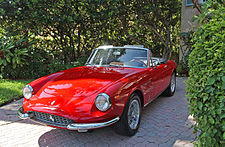Ferrari 330
| Manufacturer | Ferrari |
|---|---|
| Production | 1963–1968 |
| Class | Sports car |
| Layout | FR layout |
| Engine | 4.0 L Colombo V12 |
The Ferrari 330 cars are the successor of the 250, first introduced by Ferrari in 1963. The first 330 America was simply a 250 GT/E with a larger engine, and the 330 GTC/GTSshared their chassis with the 275. Only the 330 GT 2+2 was a truly unique product. Production ended in 1968 with the introduction of the Ferrari 365 series.
All 330 models used an evolution of the 400 Superamerica's 4.0 L Colombo V12 engine. It was substantially changed for the 330 cars, however, with wider bore spacing and the notable use of a true alternator rather than a dynamo generator.
330 America
 | |
| Production | 1963 50 produced |
|---|---|
| Predecessor | Ferrari 250 GT/E 2+2 |
| Successor | Ferrari 330 GT 2+2 |
| Body style | 2+2 Berlinetta |
The 1963 330 America shared the outgoing 250 GTE's chassis but not its engine, being powered by the new Type 209, 300 hp (220 kW) at 6600 rpm, 4.0 L engine.
Socialite Sandra West is buried with her blue 330 America at the Alamo Masonic Cemetery at San Antonio, Texas.
50 330 Americas were built.
330 GT 2+2
 | |
| Production | 1964–1967 1087 produced |
|---|---|
| Predecessor | Ferrari 250 GT/E 2+2 Ferrari 330 America |
| Successor | Ferrari 365 GT 2+2 |
| Body style | 2+2 Berlinetta |
The 250 GT/E 2+2 was replaced in January, 1964 by the new 330 GT 2+2. It was much more than a re-engined 250, however, with a sharper nose and tail, quad headlights, and a wide grille. The wheelbase was 50 mm (2.0 in) longer, but Koni adjustable shock absorbers improved handling. A dual-circuit Dunlop braking system was used with discs all around, though it separated brakes front to back rather than diagonally as on modern systems.
The 1965 Series II version featured a five-speed gearbox instead of the overdrive four-speed of the prior year. Other changes included the switch back to a dual-light instead of quad-light front clip, alloy wheels, and the addition of optional air conditioning and power steering. Prior to the introduction of the 'Series II' 330 GTs, a series of 124 'interim' cars were produced, with the 4-headlight external configuration of the Series I cars, but with the 5-speed transmission and 'suspended' foot pedals of the 'Series II' cars.
627 Series I (including 124 'interim' cars) and 460 Series II 330 GT 2+2 cars had been built when the car was replaced by the 365 GT 2+2 in 1967.
330 GTC/GTS
 | |
| Production | 1966–1968 GTC: 600 produced GTS: 100 produced |
|---|---|
| Predecessor | GTC: Ferrari 250 GT GTS: Ferrari 275 GTS |
| Successor | GTC: Ferrari 365 GTC GTS: Ferrari 365 GTS |
| Body style | GTC: 2-seat coupé GTS: 2-seat Spider |
The 330 GTC and 330 GTS were more like their 275 counterparts than the 330 GT 2+2. They shared the short wheelbase of the 275 as well as its independent rear suspension.
The GTC berlinetta was introduced at the Geneva Motor Show in March, 1966. It was a 2-seat coupe with a Pininfarina-designed body. A 1967 GTC was given one-off bodywork byZagato at the behest of American importer Luigi Chinetti in 1974. This car was called the "Zagato Convertibile", since it was of a targa-style.
The GTS spider followed at the Paris Motor Show. About 600 coupés and 100 spiders were produced before the 1968 introduction of the 365 GTC & GTS and the 365 GTB/4 "Daytona".
330 LMB
Four 330 Le Mans Berlinettas were built in 1963. They were essentially a development of the 250 GTOs and fitted with the 4-litre 330 engine. Although visually similar to the 250 GTOs, there are numerous body differences; these four cars are not the same as the "330 GTOs".
330 P
Four models of mid-engined racing cars used the 330 engine and name as well — the 330 P/P2/P3/P4 range of the mid 1960s. The 330 P4 had 450 bhp at 8500 rpm. It had a top speed of 320 km/h (198.85 mph). And had a dry weight of 800 kg (1763 lb).






![Validate my RSS feed [Valid RSS]](valid-rss-rogers.png)















































































ไม่มีความคิดเห็น:
แสดงความคิดเห็น